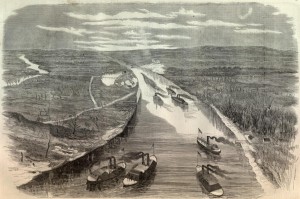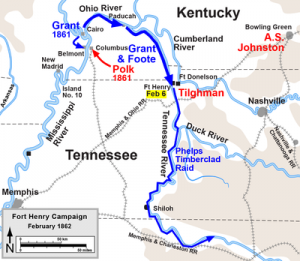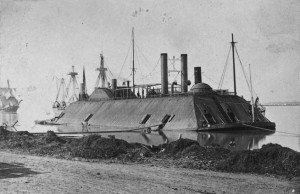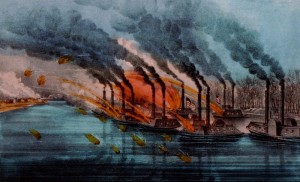Fort Henry was a Confederate garrison on the Tennessee River, the capture of which was the first significant Union victory of the Civil War.
Because of its food production, mineral resources, labor supply, and railroads, Tennessee was the key to the West. While the Confederates enjoyed unity of command in the Western theater under General Albert Sidney Johnston, Union forces there were divided between the Department of the Missouri, commanded by Major General Henry W. Halleck, and the Department of the Ohio under Brigadier General Don Carlos Buell. Despite their twofold superiority in manpower, the two Union commanders disagreed on strategy and claimed insufficient resources and logistical problems.
Halleck’s subordinates, Brigadier General Ulysses S. Grant, who commanded the Cairo Military District with 20,000 men, and Flag Officer Andrew H. Foote, who commanded the Western Flotilla, both wanted to attack Fort Henry on the Tennessee and Fort Donelson on the Cumberland River. This would flank the powerful Confederate fortress at Columbus on the Upper Mississippi, and Confederate defenders at Bowling Green, Kentucky.
Halleck saw the need to offset successes by Buell in Kentucky, and President Lincoln was also applying pressure. But what finally prompted him to act was an erroneous report that Richmond was sending reinforcements west. On 30 January, Halleck ordered Grant to take and hold Fort Henry. The Union expedition set out on 2 February.
Fort Henry covered three acres of ground in a solidly built five-sided earthwork parapet. Rifle pits extended to the river and two miles east toward Fort Donelson. Although it lay in a bend of the Tennessee River, commanding a straight stretch of water three miles long, Fort Henry was on low ground washed by the river and had higher terrain on both sides. Work to fortify the heights on the west bank, known as Fort Heiman after Fort Henry’s second in command, was incomplete when the Federal’s arrived. Brigadier General Lloyd Tilghman commanded both Forts Henry and Donelson.
Fort Henry mounted seventeen heavy guns: twelve faced the river and five guarded the land approaches. the fort had eight 32-pounders, two 42-pounders, one 128-pounder Columbiad rifled gun, five long 18-pounder siege guns, and a 6-inch rifled gun.
In early February 1862 the Tennessee was in flood and some of the land within the fort’s perimeter was two feet under water. The Confederates also had no ammunition for their 42-pounders, leaving only nine guns able to counter a water approach. Tilghman also had only 2,610 men in two brigades under Colonels Adolphus Heiman and Joseph Drake. Many were raw recruits who had only shotguns and hunting rifles; some had only flintlocks.
On 2 February the Union flotilla left Cairo. Four ironclads led: the Cincinnati (flagship), Carondelet, Essex, and St. Louis. The transports followed, and a division of timberclads brought up the rear: the Conestoga, Lexington, and Tyler. Two lifts were necessary to transport all of Grant’s 17,000 men.
Early on the 4th the Confederates learned of the Union advance. Tilghman then left Fort Donelson to take up direction of Fort Henry’s defense. Although Tilghman telegraphed General Leonidas Polk at Columbus for reinforcements, none were sent.
Grant debarked his troops three miles from the fort and just beyond the range of its guns. He then returned to Paducah with the empty transports to hurry the second lift of Brigadier Charles F. Smith’s division.
Late on the 5th three of the Union gunboats approached Fort Henry and opened a “vigorous and well-directed fire,” which killed one defender and wounded three others. The Confederates replied with six shots and the gunboats then withdrew.
All Union troops were not ashore until the night of the 5th, when it rained heavily. Although he did not yet have all his men in place, Grant believed that prompt action was imperative to prevent the Confederates from reinforcing. Hopefull all his men would have arrived in time, Grant ordered the advance to begin at 11:00 A.M. on the 6th.
Grant planned a simultaneous land and water attack. During the night of the 5th he sent Smith with two of his brigades along the west bank of the river to prevent any reinforcement from that direction, to cut off a Confederate escape, and to seize Fort Heiman for possible artillery emplacement. Smith’s men discovered that the Confederates had already evacuated Heiman. Brigadier General John A. McClernand’s division with a brigade from Smith mounted the main Union land effort on the east bank.
On the night of the 5th, Tilghman called together his officers. All were pessimistic, believing they could not withstand an attack by a force they estimated at 25,000 men. At 10:00 A.M. on the 6th Tilghman ordered all defenders except for the artillery company manning the batteries to withdraw to Fort Donelson. This left only about a hundred men, including those too sick to move. Tilghman intended to delay the attackers long enough for the rest of his command to escape.
At 10:50 the Union flotilla got under way, the iron-clads forming in line abreast: the Essex on the right, then the Cincinnati, Carondelet, and St. Louis. Because of the narrowness of the river, the last two gunboats were lashed together and remained so during the battle. A half-mile behind them came Lieutenant Seth L. Phelp’s division of timberclads. As the flotilla neared Fort Henry there was no sign of the Union troops, and Foote decided to begin the battle alone. At 11:45, from about 1,700 yards’ range, the Cincinnati fired a shot, the signal for the other gunboats to open fire. At about a mile’s range Taylor ordered the water battery to respond, and firing then became general. Phelp’s division remained at long range, lobbing shells into the fort.
Confederate fire was both lively and accurate. Although Fort Henry had only nine guns that could respond, the rebel gunners succeeded in hitting all gunboats many times (fifty-nine hits in all) but most of the damage was slight, except to the Essex, when a Confederate shell tore into its middle boiler. The blast and steam killed or wounded thirty-two men, including Commodore William D. Porter, who was seriously scalded. The gunboat drifted out of control downriver but was towed to safety by a tug. a seaman was also killed and nine others wounded on board the Cincinnati. A musket ball killed another man aboard the Essex.
From the beginning Union fire was quite accurate, and the crews could see shell explosions throwing up earth around the rebel guns. Then the 6-inch rifled gun blew up, killing or wounding all its crew, and a priming wire stuck in the vent of the 10-inch Columbiad, spiking it. Two 32-pounders were then struck at almost the same time.
With only four of his guns able to return fire and the Union gunboats sweeping the fort with their fire, at 2:00 P.M. Tilghman surrendered. He had saved the bulk of the garrison. Only ninety-four men, including Tilghman and sixteen aboard a Confederate hospital boat, surrendered at Fort Henry. Confederate losses were only five dead, eleven wounded and five missing. The victors did capture Fort Henry’s guns as well as supplies and equipment abandoned by the garrison, which had retreated to Fort Donelson on foot without wagons.
The roads were mired in mud, and the Union land force arrived at Fort Henry only after the battle. McClernand had learned that he Confederates might be evacuating Fort Henry and sent cavalry ahead to verify it. It pursued the retreating Confederates, who were slowed by muddy roads, and captured six guns and thirty-eight stragglers. But the first Union troops did not arrive at Fort Henry until an hour after its surrender.
Immediately after the capture of Fort Henry, Grant called together his officers to discuss the possibility of taking Fort Donelson. All declared themselves in favor of moving against Fort Donelson as soon as possible.
- Spencer C. Tucker
[Source: Heidler, David S. and Jeanne T. Heidler. Encyclopedia of the American Civil War: A Political, Social and Military History. W.W. Norton & Co. 2002. pp. 735-736]
For Further Reading:
- Cooling, Benjamin Franklin. The Campaign for Fort Donelson. National Park Service Civil War series. Fort Washington, PA: U.S. National Park Service and Eastern National, 1999.
- Cooling, Benjamin Franklin. Forts Henry and Donelson: The Key to the Confederate Heartland. Knoxville, TN: University of Tennessee Press. 2003.
- Eicher, David J. The Longest Night: A Military History of the Civil War. New York: Simon & Schuster, 2001.
- Esposito, Vincent J. West Point Atlas of American Wars. New York: Frederick A. Praeger, 1959. The collection of maps (without explanatory text) is available online at the West Point website.
- Gott, Kendall D. Where the South Lost the War: An Analysis of the Fort Henry—Fort Donelson Campaign, February 1862. Mechanicsburg, PA: Stackpole Books, 2003.
- McPherson, James M. Battle Cry of Freedom: The Civil War Era. Oxford History of the United States. New York: Oxford University Press, 1988.
- Simon, John Y., ed. Papers of Ulysses S. Grant: January 8 - March 31, 1862. Vol. 4. Carbondale: Southern Illinois University Press, 1972.
- Woodworth, Steven E. Nothing but Victory: The Army of the Tennessee, 1861–1865. New York: Alfred A. Knopf, 2005.
Confederate Forces
BRIGADIER GENERAL LLOYD TILGHMAN
1st Brigade - Colonel Heiman
27th Alabama Infantry Regiment— Colonel Hughes
10th Tennessee Infantry Regiment— Lieutenant Colonel MacGavock
48th Tennessee Infantry Regiment— Colonel Voorhies
Tennessee Cavalry Battalion— Lieutenant Colonel Gantt
Light Artillery Battery— Captain Culbertson
2nd Brigade - Colonel Joseph Drake
Alabama Infantry Battalion— Major Gavin
15th Arkansas Infantry Regiment— Colonel Gee
4th Mississippi Infantry Regiment— Major Adaire
51st Tennessee Infantry Regiment— Colonel Browder
Alabama Cavalry Battalion — Captain Leach
Milner’s Alabama Cavalry Company— Captain Milner
Padgetts Spy Company— Captain Padgett
Detachment Milton’s Rangers— Acting Captain Milton
Light Artillery Battery— Captain Cain
Heavy Artillery Battery— Captain Taylor
CASUALTIES= Killed 2, Wounded 4, Mortally Wounded 1
Union Forces
BRIGADIER GENERAL ULYSSES GRANT
1st Division - Brigadier General John Alexander McClernand
1st Brigade - Colonel Richard J. Oglesby
8th Illinois Infantry Regiment— Lieutenant Colonel Frank L. Rhoads
18th Illinois Infantry Regiment— Colonel Michael K. Lawler
29th Illinois Infantry Regiment— Colonel James S. Reardon
30th Illinois Infantry Regiment— Lieutenant Colonel Elias S. Dennis
31st Illinois Infantry Regiment— Colonel John Alexander Logan
Battery “L”, 2nd Illinois Artillery— Lieutenant G. C. Gumbart
Battery “D”, 2nd Illinois Artillery— Captain Thomas J. Larrison
Companies “A” and “B”, 2nd Illinois Cavalry— Captain John R. Hotaling
Company “C” and “I”, 4th U.S. Cavalry— Lieutenant James Powell
Independent Company, Illinois Cavalry— Captain E. Carmichael
Independent Company, Illinois Cavalry— Captain James Dollins
Independent Company, Illinois Cavalry— Captain M. J. O’Harnett
Independent Company, Illinois Cavalry— Lieutenant Ezra King
2nd Brigade - Colonel W. H. L. Wallace
11th Illinois Infantry Regiment— Lieutenant Colonel T. E. G. Ransom
20th Illinois Infantry Regiment— Colonel C. Carroll Marsh
45th Illinois Infantry Regiment— Colonel John E. Smith
48th Illinois Infantry Regiment— Colonel Isham N. Haynie
Battery “B”, 1st Illinois Artillery— Captain Ezra Taylor
Battery “D”, 1st Illinois Artillery— Captain Edward McAllister
4th Illinois Cavalry Regiment— Colonel T. Lyle Dickey
2nd Division - Brigadier General Charles F. Smith
3rd Brigade - Colonel John Cook
7th Illinois Infantry Regiment— Lieutenant Colonel Andrew J. Babcock
50th Illinois Infantry Regiment— Colonel Moses M. Bane
52nd Illinois Infantry Regiment— Colonel James M. Smith
12th Iowa Infantry Regiment— Colonel J. J. Wood
13th Missouri Infantry Regiment— Colonel Crafts J. Wright
Battery “D”, 1st Missouri Artillery— Captain Henry Richardson
Battery “H”, 1st Missouri Artillery— Captain F. Welker
Battery “K”, 1st Missouri Artillery— Captain George H. Stone
U.S. Naval Forces
FLAG OFFICER ANDREW HULL FOOTE
U.S.S. CINCINNATI (Flag Ship)
Commander R. N. Stembel
Master William R. Hoel
Master Oscar H. Prattt
Master Charles G. Perkins Master John Pearce
Pilot R. H. Attenborough
Pilot Isaac D. Gaugh
Surgeon John Ludlow
Surgeon Baron Proctor
Chief Engineer William D. McFarland
1st Assistant Engineer Samuel H. Lovejoy
2ndt Assistant Engineer James Armstrong
3rd Assistant Engineer William J. Shannon
Master’s Mate James McB. Stembel
Master’s Mate Philip Shell
Acting Gunner John R. Hall
Carpenter Thomas B. Gregory
Armorer Jacob Vitinger
U.S.S. ESSEX
Commander William D. Porter
Master Robert K. Riley
Master James Laning
Master Theodore P. Ferry
Master George W. Walker
Pilot James McBride
Pilot Marshall H. Ford
Surgeon Thomas Rice
Paymaster Joseph H. Lewis
Chief Engineer Charles M. Blasdell
1st Assistant Engineer R. J. Stearns
2nd Assistant Engineer George D. Simms
3rd Assistant Engineer Jeremiah Wetzel
Master’s Mate S. B. Brittan
Gunner Matthias B. Snyder
Carpenter Thomas Steel
Armorer Fletcher
U.S.S. CARONDELET
Commander Henry Walke
Master Richard M. Wade
Master John Doherty
Master Charles C. Gray
Master Henry A. Walke
Pilot William Hinton
Pilot Daniel Weaver
Assistant Surgeon James S. McNeely
Acting Paymaster George W. Nixsin
Chief Engineer William H. Faulkner
1st Assistant Engineer Charles Craven
2nd Assistant Engineer Samuel S. Brooks
3rd Assistant Engineer Augustus F. Crowell
Master’s Mate Theodore L. Gilmore
Master’s Mate Edward E. Brennand
Gunner Richard Adams
Carpenter Oliver Donaldson
Armorer H. H. Rhodes
U.S.S. ST. LOUIS
Lieutenant Commander Leonard Paulding
Master John V. Johnson
Master James Y. Clemson
Master Charles S. Kendrick
Master Alexander Fraser
Assistant Surgeon John B. McDill
Acting Paymaster Llewellyn Curry
ilot Frank A. Riley
Pilot Robert G. Baldwin
Chief Engineer William Carswell
1st Assistant Engineer T. F. Ackerman
2nd Assistant Engineer James L. Smith
3rd Assistant Engineer John Wilcoxsen
Master’s Mate Sydney H. McAdam
Master’s Mate James P. Pauldingbr>Acting Gunner John A. McDonald
Carpenter Robert H. Medillff
Armorer Sypher
U.S.S. CONESTOGA
Lieutenant Commander S. L. Phelps
Master John A. Duble
Master Charles P. Noble
Master Benjamin Sebastian
Master Richard H. Cutter
Pilot Aaron M. Jordan
Pilot William Attenborough
Assistant Surgeon William H. Wilson
Acting Paymaster Alfred Phelps
Chief Engineer Thomas Cook
1st Assistant Engineer Alexander Magee
2nd Assistant Engineer Charles Marshall
3rd Assistant Engineer Michael Norton
Master’s Mate James Kearney
Acting Gunner Henry Hamilton
Carpenter Andrew Woodlock
Armorer James O’Neil
U.S.S. TYLER
Lieutenant Commander William Gwin
Master Edwin Shaw
Master Jason Goudy
Master James Martin
Master Patrick McCarty
Pilot John Sebastian
Pilot David Hiner
Assistant Surgeon Thomas H, Kearney
Acting Paymaster William B. Coleman
Chief Engineer Samuel Goble
1st Assistant Engineer D. Edward Weaver
2nd Assistant Engineer Edward W. Gobel
3rd Assistant Engineer Oscar S. Davis
Master’s Mate Ferdinand T. Coleman
Acting Gunner Herman Peters
Carpenter Thomas Russell
Armorer Elihu Stevens
U.S.S. LEXINGTON
Lieutenant Commander James W. Shirk
Master Jacob S. Hurd
Master Martin Dunn
Master James Fitzpatrick
Master Sylvester Poole
Pilot James McCamant
Pilot William Ford
Assistant Surgeon George W. Garver
Acting Paymaster Augustus F. Taylor
Gunner Samuel Vroon
Carpenter Richard Carroll
Armorer Reuben Story







Pingback: Brigadier General Lloyd Tilghman, C.S.A. (Jan. 18,1816- May 16,1863) | This Week in the Civil War
Pingback: This Week in the American Civil War - Feb. 12-18, 1862 | This Week in the Civil War
Pingback: Ulysses Simpson Grant - 18th U.S. President and General-in-Chief of the U.S. Army (1822-1885) | This Week in the Civil War
Pingback: On this date in Civil War history: April 6-7, 1862-Battle of Shiloh | This Week in the Civil War
Pingback: Battle of Fort Donelson (Feb. 13-16, 1862) | This Week in the Civil War